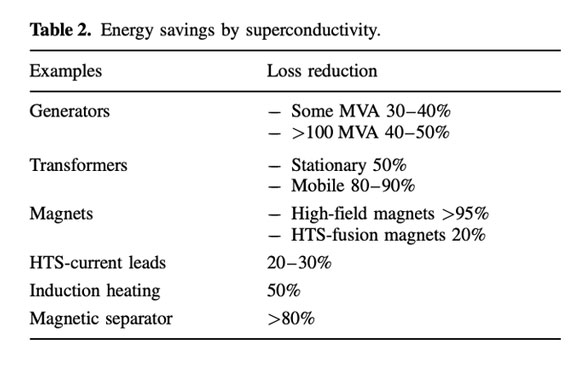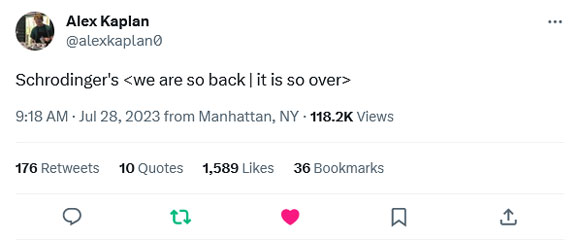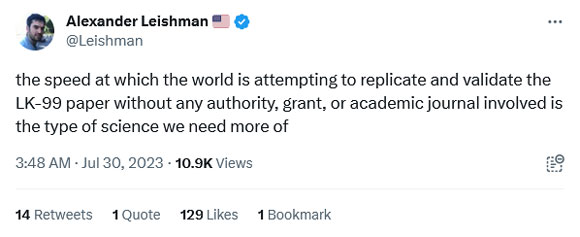I was scrolling through my Twitter (sorry, X as it’s now called) feed late Wednesday evening.
The good thing about Twi…err I mean X, is that you can follow all sorts of experts from many different fields.
And over the past 12 years on the platform, I’ve built up a well-curated list of very knowledgeable people I follow.
In fact, these days, I reckon I get 99% of my news and information this way.
[Editor’s note: I frequently ‘retweet’ any stories — mostly about new tech, Bitcoin, economics, and other investing ideas — I find interesting. You can follow me on Twitter (X.com) at @konfidinse to follow these ideas too.]
When I occasionally check in to see what the mainstream news is reporting, it’s almost like a different world!
And I know which one I trust more…
Anyway, on that Wednesday evening, one particular tweet made me sit up straight in bed.
You see, an amazing scientific story was playing out in real time.
If it’s proven true — and we’ll very much know this week if it is — then the implications are profound.
Let me explain…
This changes everything
The tweet in question was this one from Princeton physics graduate Alex Kaplan:
|
|
|
Source: X |
So what did Alex see that made him so excited?
Well, last week, a new paper was published by several well-known Korean scientists claiming they’d discovered one of the holy grails of physics.
Namely, the discovery of the first ever room-temperature, ambient-pressure superconductor (SC).
A superconductor is a material that transmits electricity without resistance.
In the past, we’ve only been able to create such materials at very, very low temperatures and at high pressure.
This has made them unfeasible for most real-life situations.
But a room-temperature superconductor opens up amazing possibilities.
Energy is probably the biggest one.
Imagine transmission lines that don’t ‘leak’ electricity.
100kWh (kilowatt hours) is lost each year in the US alone thanks to this energy loss. That’s the equivalent of three large nuclear reactors running 24/7 365 days a year.
At the generation point huge savings could be made too.
Check out the table:
|
|
|
Source: X |
These are big figures. And when you extrapolate them out into the world, it changes the economics for the entire energy market.
What else?
Well, how about a phone that doesn’t turn into a mini oven when you’re looking at TikTok videos all day!
Remember, no resistance means no heat so your phone won’t get hot. It also means no noisy, cooling fans whirling away in your computer either.
What’s more, because superconductors are the perfect batteries, you probably won’t have to recharge your phone very often either.
Or anything really!
You simply inject a current into an SC coil until you need it.
There’s more…
How about quantum computers in everyone’s home? Or even levitating trains that could do New York to Los Angeles in less than an hour?
These both become possible with the advent of a viable room-temperature superconductor.
This was the future we were promised!
|
|
|
Source: X |
I’ve barely touched the surface of what this technology makes possible. As Alex Kaplan tweeted, it’s a big deal and probably even bigger than AI in terms of its impact.
Happy days then?
Not so fast…
As I’ll show you now, there’s a lot of scepticism about this paper and if the claims will hold up to closer scrutiny…
The drama of LK-99
Since Alex’s tweet went viral (over 29 million views since), it’s been a drama-filled week.
A number of leading scientists and researchers have expressed scepticism of the paper’s findings, pointing out basic flaws, mislabelled graphs, and seemingly conflicting data.
What’s more, the six authors themselves seem to be fighting each other. One rumour I read said that the paper was rushed out because one of the author’s thought he was about to be dealt out of any credit.
Even a video from the paper’s team showing a piece of levitating metal — one of the consequences of superconductivity — has attracted detractors who say that this looks more like a form of plain old magnetism (not SC).
And the original tweeter, Alex Kaplan, has flip-flopped from optimism to pessimism as the scientific rumour mill went into overdrive, eventually conceding:
|
|
|
Source: X |
The joke here refers to the famous Schrodinger’s cat thought experiment in quantum physics, where a cat in a box can be thought to be both dead and alive at the same time.
A bit like this discovery!
The good news?
It seems that the process of creating the superconducting material in question, LK-99, is actually pretty straightforward.
And already, labs around the world are racing to try and reproduce the paper’s findings, including one engineer I follow who is live streaming his attempts on Twitter.
Overall, I’ve found this a very refreshing approach to science.
No matter what anyone thinks, says, or what their qualifications are, we’ll likely know if LK-99 is the real deal or not by sometime this week.
The proof, as they say, will be in the pudding.
And that, my friend, is how science is supposed to work.
Replicable, testable results that either confirm or deny a hypothesis. Not by ‘consensus’, appeals to authority, or any other pseudo-scientific signalling mechanisms.
As this tweet puts it:
|
|
|
Source: X |
Good science is either true or not.
And if it can’t be proven either way, then it’s not science. It’s faith or some other belief system.
Today, too many people trust ‘the experts’ unquestioningly over the proper scientific method.
This is dangerous but isn’t anything new.
Don’t forget that even the great Albert Einstein’s discovery of relativity was mocked by the intelligentsia of the day.
A book was even published, signed by 100 leading scientists, saying why Einstein was wrong.
Einstein quipped back in reply:
‘If I were wrong, they wouldn’t need 100 scientists, just one would do.’
His point being was that weight of scientific numbers meant diddly-squat. One valid critique was all that was needed.
The famous 20th century philosopher Karl Popper took this one stage further and argued the goals of science was essentially to disprove current theories, as only then could you arrive at better versions of reality.
Anyway, I thought this a point worth making, especially given the days we live in.
There are attempts to radically change how we live with appeals to ‘scientific consensus’ as the justification.
And yet, a lot of this science isn’t allowed to be debated and, in most cases, don’t provide testable predictions — at least not accurate ones.
It’s why I’ve found this LK-99 debate on Twitter so refreshing.
You’re watching real-time science where the ideas are debated furiously, but it’ll ultimately come down to whether the paper stacks up or not to reality.
There’ll be a lot of egg on faces if it does (from the expert sceptics) and potential career death for the paper’s authors if it doesn’t.
A big week ahead for a lot of people!
And if it’s true, it’ll be an immense moment for all of us.
Good investing,
 |
Ryan Dinse,
Editor, Money Morning
PS: Follow me at @konfidinse on Twitter (X.com) for live updates on this and other investing topics.
PPS: For a sceptical take on LK-99 and the hype behind it, this piece here is worth reading. As I said at the start, reading a wide range of views and not just confirming your bias is one of the benefits of getting your information away from the mainstream.






